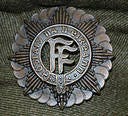Investigating Crimes of War: Experiences and Issues (part 6)
‘Media and Modern War Crime; and effects of past misdeeds’
By Col Des Travers (ret’d)
About the Author: having served for 42 years career with the Irish Army, Des Travers’ last appointment was as Colonel, Commandant of the Military College. In his time, he served with UNFICYP (1964, 1969–70), UNIFIL (1980–82, 1984–85 and 1987–88), in Croatia (EU Monitor in 1993) and in Bosnia and Herzegovina (2000–01) before retiring in 2001.
In 2003, Travers was invited join the Institute for International Criminal Investigations based in The Hague. He later became a director at the Institute. Asked to participate in the UN Fact Finding Mission on the Gaza Conflict, the report submitted to the Human Rights Council on 30 Sep 2009 has come to be known as “The Goldstone Report”.
Modern technologies that have created and influenced social media have also entered the military sphere. In the past, during my peacekeeping days, analyses of incidents were often relatively uncomplicated. An incident was to be investigated; an impact site or crater was examined; witnesses, if any, were interviewed; a determination as to who the perpetrator may be was arrived at. If the impact or house-blowing had certain characteristics and debris, it was usually possible to make a determination as to who was the perpetrator and why. If, for example, the impact and debris revealed a projectile of Soviet origin, say a Katyusha rocket, then it could be assumed it was fired by a Palestinian or Islamic element — whichever was in the ascendent in Lebanon at that time.
Similarly, if the impact site was a crater and the crater’s configuration and its debris indicated a HE shell of 155mm calibre that came from a gun-position south east of there, then it could be assumed that it was fired by an IDF artillery battery or by their proxy the LAUI (Lebanese Armed and Uniformed by Israel) of Maj. Saad Haddad.
Blowing up of houses, tit-for-tat and often caused by family feuds, could also be analysed and reliable findings made. And so on.
In recent years, complications have arisen in the investigation sphere. This arises especially where incidents were likely to have been caused by government forces, forces that have the back-up resources to manage and manipulate the media. In some cases, an incident which had been captured by video has caused other unspecified agencies to be able to produce videos which tell an opposite story.
In this case, the services of a public relations firm based in the UK was hired to manufacture and manage misinformation. This they did quite effectively. This is, to my mind, aiding and abetting and should be treated accordingly.
The attack on the freedom flotilla vessel the MV Marmara on the high seas in 2010 is one such case. Videos were produced which seemed to show crew and passengers beating with belaying pins the IDF soldiers who had rappelled on board from helicopters.
Another example which is a concern relates to the disclosure of videos by Sri Lankan army personnel. In them, are scenes of the naked bodies of young Tamil women laid out in a row while Sri Lankan soldiers walked among them making lewd or derogatory comments about them. Later videos show these bodies being dragged by the heels and dumped into military trucks. Blurred versions of these videos are available to view on YouTube. The unblurred videos are much more disturbing.
The blurring of these grim scenes may mollify the squeamish. They also serve the interests of the perpetrators. They do so by diminishing the horror of these crimes for the viewer. They permit low cost ‘fake’ videos of similar scenes, but where the ‘soldiers’ portrayed in them are speaking Tamil! Even obvious fakes induce doubt as to the veracity of the originals. That is sufficient in itself.
The war crimes known or suspected to have occurred during the closing days of the Sri Lankan — Tamil war, which occurred during the early months of 2009 have not been subject to trial by the international community. There are various reasons for this, which I do not intend to discuss here as they are non-analysis issues.
Effects of past misdeeds
A look back at these conflicts is merited. A significant number of them arise from ethnic or cultural impositions or the prioritisation of minorities by colonial powers. These left a heritage of discord in their wake. Oftentimes, such realignments were done for both economic and divisive reasons by the colonial power in question. They continue to be issues today. It is my opinion that the history of colonialism in any one case cannot be fully tallied until a century has elapsed post-colonialism.
The democratic world has been the dominant entity in the ongoing development of human rights and crimes against humanity. Many of our more successful democracies were colonial powers in the past. Sometimes the spectre of that past seems to invade events in the present. Put another way, the Nuremberg trials have been criticised as ‘victors’ justice’. Its modern variant seems to have segued into ‘westernised justice’.
By all accounts, democracy is undergoing new challenges, both internally and externally. Recession circumstances have fuelled the fire and we see a growing disinclination to engage with the plight of others. Europe’s seemingly growing indifference to the influx of refugees is a case in point.
No one could have anticipated a slamming of doors of such intensity as that of a Secretary of State of the world’s greatest democratic power’s message to the President of the International Criminal Court when he wrote:
“…Dear Madame Prosecutor,
You are dead to us.
Sincerely…”
Yes, we have progressed.
Now, we have to be watchful.
[This posting includes the series of articles by the author.]
